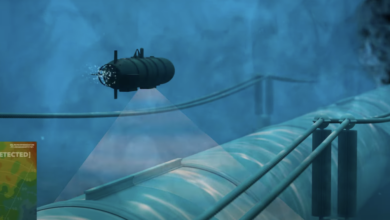
Under the Biden administration, the Pentagon has become increasingly serious about climate change. The Department of Defense’s 2021 Interim National Security Strategic Guidance used the phrases “climate change,” “climate crisis,” or “climate emergency” 20 times, the same number of times it mentioned China and Russia.
Recently, the department came up with a Climate Risk Analysis and a Climate Adaptation Plan to comply with President Joe Biden’s executive order on “tackling the climate crisis at home and abroad.” More policy changes are likely coming.
However, the department’s message in these documents remains the same as it has in past years, though it now employs a stronger emphasis: Climate change is real, it is driving security risks, and the military needs to be prepared to adapt.
But these publications do not commit the department to mitigate climate change by lowering greenhouse gas emissions, shifting to alternative fuels, or meeting new efficiency standards, but only to adapting to the effects of climate change.
While well-meaning, these developments focus on helping the Pentagon react to climate change and do little to address the military’s contribution to climate change.
US Military Carbon Emissions
According to Brown University’s Costs of War Project, the US Department of Defense is the “world’s largest institutional user of petroleum and correspondingly, the single largest producer of greenhouse gases in the world.”
Other reporting cautions that US military carbon emissions, like many other militaries around the world, are likely significantly underreported.
It can use as many as 350,000 barrels of oil per day, accounting for roughly 80 percent of all fossil fuels consumed by the federal government. The DoD’s daily fuel consumption is so high it amounts to more than that used by most countries, including Portugal and Sweden.
Opportunity
If the Pentagon is serious about climate change, it needs to make reducing its own contribution to the problem a key pillar in its plans.
Instead of solely focusing on adapting to the security challenges of climate change, the US military should look at green technology trends as an opportunity to create advantages over its adversaries.
Fossil fuels have long been viewed as a constraining factor to operations. In 2003, former Marine general and Secretary of Defense James Mattis famously asked that the military be “unleashed from the tether of fuel.”
Alternative energy sources and fuel supplies could help US forces operate longer on less. Electric motors powered by batteries or hydrogen fuel cells are also much quieter and run cooler than internal combustion engines, reducing their thermal and audible signatures and giving them an advantage in contested environments.

Alternative Energy Trend
Alternative fuel technology is booming in the commercial sector, which the military should use to its advantage.
General Motors has declared that it’s on the way to an “all-electric future,” Ford expects to have as much of 50 percent of its total vehicle sales all-electric by 2030, Volkswagen expects nearly all of its cars to be “zero-emission” by 2040, and Volvo has committed to only selling electric vehicles by 2030.
Shipbuilders have also announced new alternative-fueled designs, such as a methanol-fueled towboat and a new hydrogen fuel cell for smaller boats.
The alternative energy trend has also taken to the skies. Airbus announced that it would design and build a family of hydrogen-powered aircraft, and Embraer is investing in electric vertical take-off and landing aircraft.
The DoD can benefit from the research and investment industry is already doing by being a “fast follower” and quickly adopting new technology. Failure to do so could result in a future where the military is left behind by vehicle manufacturers no longer investing in internal combustion engine technology.
Militaries Becoming Carbon Conscious
While some say that reducing the Pentagon’s carbon footprint is an impossible or impractical goal, other militaries are already becoming more carbon conscious and taking strides to reduce their carbon consumption.
The UK’s Royal Air Force has set a goal of being carbon-neutral by 2040, marking the service a defense leader in climate change policy and affirming its commitment to reaching net-zero carbon emissions by 2050.
The RAF has completed a pioneering Guinness World Record with the first flight of a fully synthetically fuelled aircraft, opening the way to the potential for zero carbon aviation. #RAFNetZero2040 #OneStepGreener #sustainability #GuinnessWorldRecords #GWRDay @GWR pic.twitter.com/2SpvFV8F02
— Royal Air Force (@RoyalAirForce) November 17, 2021
The US military can learn from this example and commit itself to lowering carbon emissions and cutting its contribution to climate change beyond simply adapting the force to deal with it.
NATO Secretary General Jens Stoltenberg has also called for the alliance to “do its part to look into how we can reduce emissions from military operations,” arguing that new technology can reduce emissions and improve combat capability at the same time.
Green Energy Arms Race
The Department of Defense also has an opportunity to be a global leader in green military technology, but to do so, it has to compete in what some experts are calling a “green energy arms race.”
Doing so is not only the right move for the climate, but can also be a winning play in competition with China, where President Xi Jinping has pledged to reach net-zero emissions by 2060.
Beijing has identified renewable energy as a strategic sector and invested state resources in industrial espionage against companies like Westinghouse Nuclear and Solar World to gain an advantage.
Pentagon investment in green technology competition can help maintain US technology dominance in critical sectors like batteries, electric vehicles, and solar power — and provide massive opportunities for US companies to sell their innovations worldwide.
Strategic competition is not incompatible with progressive climate policy.
Pentagon Must Scale Up
The Pentagon has been noting the risks of climate change for years, increasingly dealing with the impacts of severe storms and floods. And it has been successful in employing renewable energy generation on its domestic bases, nearly doubling the amount of renewable energy generated between 2011 and 2015.
The military also has a range of pilot projects and experiments, including hydrogen-powered vehicles in Hawaii and electricity generated from a landfill at a Marine Corps base in California.
But so far, nearly all the investment has been at bases within the US — far less effort has been put into operational energy, which is just as important.
If the Pentagon is serious about tackling climate change, it needs to start finding ways to reduce its own contribution beyond the scattering of service-level initiatives that already exist.
The Department of Defense needs to invest in alternative energy and fuels for new platforms and see other creative ways to start weaning itself off of fossil fuels used for operational energy at home and abroad.
If the US military fails to lead in “green lethality,” another country will, and it will reap the benefits as public pressure forces governments to commit to increasingly aggressive climate policies around the world.
 Walker D. Mills is a United States Marine Corps officer serving in Cartagena, Colombia and is the 2021 Military Fellow with Young Professionals in Foreign Policy and a non-resident WSD-Handa Fellow at Pacific Forum.
Walker D. Mills is a United States Marine Corps officer serving in Cartagena, Colombia and is the 2021 Military Fellow with Young Professionals in Foreign Policy and a non-resident WSD-Handa Fellow at Pacific Forum.
The views expressed are his alone and do not represent the United States government, the Colombian government, the United States military, or the United States Marine Corps.
The views and opinions expressed here are those of the author and do not necessarily reflect the editorial position of The Defense Post.
The Defense Post aims to publish a wide range of high-quality opinion and analysis from a diverse array of people – do you want to send us yours? Click here to submit an op-ed.











